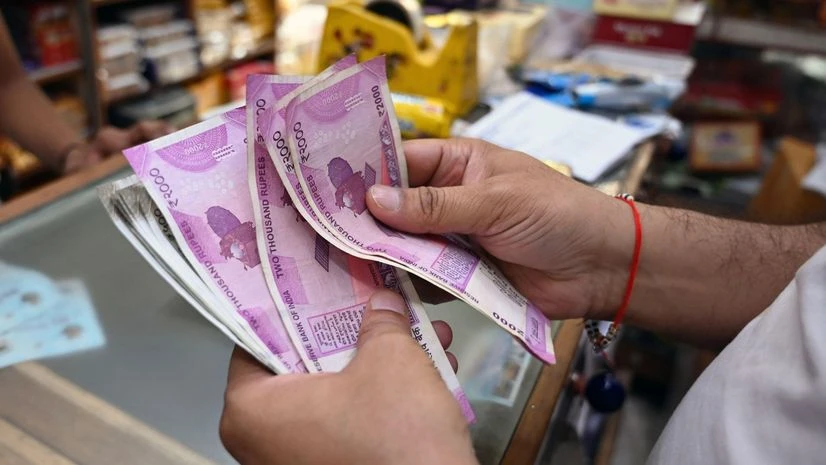The Indian rupee is the least volatile in the last twenty years and has demonstrated resilience, currently trading at 82.95 against the US Dollar and now showing signs of a structural uptrend. Factors such as narrowing current account deficit, robust forex reserves, and favourable inflation disparities support this trajectory. While RBI intervention aims to maintain stability, the overall outlook suggests a potentially appreciating rupee in the years ahead, with projections of USD/INR reaching 78 by fiscal year 2026, according to a report by YES Securities.
Indian Rupee strengthened during February 2024, helped by strong foreign capital inflows in the Indian debt market, which to an extent counterbalanced the outflows from equity markets.
RBI's persistent Intervention has been thwarting volatility, The Indian Rupee is the least Volatile in 20 years
Also Read
The Indian Rupee seems to have bottomed around 83.5 against the USD and is due for a structural uptrend, reflected by the resilience in the currency over the past 12 months
"There has been front-running by foreign banks in Debt markets given the inclusion of India’s sovereign bonds in Global Indices during the next fiscal year. After a stable 2023, the Indian rupee started 2024 on a promising note and has turned out to be the best-performing Asian currency, despite the rise in the dollar index. Market participants expect the rupee to appreciate to the 82 mark in the current calendar year given the healthy capital flows and reasonably higher balance of payment surplus. However, RBI is largely absorbing the dollar inflows which can be manifested by the trend in rising FX reserves. Persistent interventions by the Reserve Bank of India to build FX reserves are restricting the appreciation of the Indian rupee," said Hitesh Jain, strategist, Institutional Equities Research at YES Securities India.
Here are 5 reasons why YES Securities expects the rupee to appreciate to 78 against the US dollar by FY26:
Current Account Trends: A pivotal factor in bolstering the rupee is the narrowing of the Current Account Deficit (CAD), expected to transition into a modest surplus within the next two years. "This shift is propelled by governmental initiatives incentivizing outbound shipments, targeting a combined US$2 trillion value in merchandise and service exports by FY30," said the report.
Narrowing CAD has proven to be supportive for the rupee, with visibility of the Current Account turning into a modest surplus over the next two years
Narrowing CAD has proven to be supportive for the rupee, with visibility of the Current Account turning into a modest surplus over the next two years
FX Reserves and Inflows: India's burgeoning Foreign Exchange (FX) Reserves serve as a protective barrier against external vulnerabilities, ensuring adequate coverage for external debt obligations. Additionally, continuous inward remittances strengthen the nation's Balance of Payments position.
Growing FX Reserves and augmenting domestic manufacturing will ensure that India’s import cover remains within comfortable levels
Growing FX Reserves and augmenting domestic manufacturing will ensure that India’s import cover remains within comfortable levels
Market Dynamics: The Indian debt markets are poised to attract substantial foreign capital inflows, projected at $100 billion over the next three years. Despite potential volatility risks, low Foreign Institutional Investor (FII) ownership of Indian Sovereign Debt mitigates concerns. Similarly, India's Equity Markets, although not yet experiencing peak FII inflows observed in the early 2000s, offer significant potential for increased portfolio investments.
Indian Debt Markets are seen receiving foreign capital inflows worth USD 100bn over the next 3 years. Notwithstanding the hefty inflows, FII ownership of Indian Sovereign Debt will be low, which will avert the risk of high volatility
Indian Debt Markets are seen receiving foreign capital inflows worth USD 100bn over the next 3 years. Notwithstanding the hefty inflows, FII ownership of Indian Sovereign Debt will be low, which will avert the risk of high volatility
India’s Equity Markets have not yet seen the same magnitude in FII inflows when compared with the 2003-07 period. The best is yet to come given that FII Net Equity Flows as a percentage of Market Capitalization over the last ten years have averaged well below 0.5%, much lower than the 2003-07 average of 2.5%
FDI and Domestic Manufacturing: India's focus on domestic manufacturing aims to draw more foreign direct investments, particularly with the global value chain moving towards Re-Shoring. This trend is expected to drive Foreign Direct Investments as a percentage of India’s GDP higher.
Indian FDI as % of GDP is now higher than China’s, unlike 10 years ago. Indian Government’s emphasis on domestic manufacturing will continue to lure Foreign Investments
Inflation Dynamics and Monetary Policies: Historically, rupee trends have been shaped by inflation disparities between India and the US. However, with narrowing differentials and Indian inflation rates falling below the global average, the scope for INR depreciation diminishes. Furthermore, a probable alignment among major central banks on the reversal of hawkish monetary policies is anticipated to maintain stability in sovereign yield spreads, curbing significant USD upside against major currencies.
RBI Interventions: Reserve Bank of India (RBI) interventions play a crucial role in shoring up FX reserves to counter INR appreciation.
Persistent interventions by the Reserve Bank of India to build FX reserves are restricting the appreciation of the Indian Rupee

)
